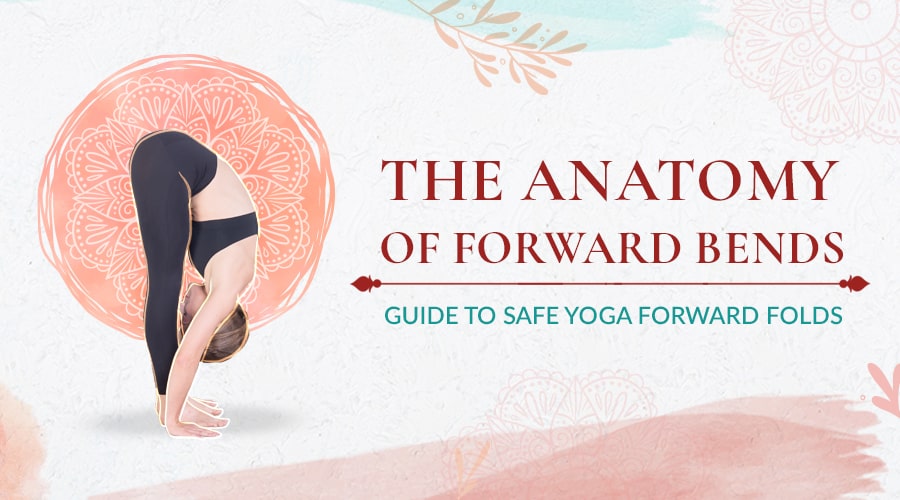Forward bending postures make up 40-60% of most yoga classes, yet there seems to be a massive knowledge and skill gap about safely practicing and teaching these fundamental folding asanas.
Essentially, forward bends are postures where the upper body moves toward the lower body. It’s widely thought that to practice this pose correctly, you need to straighten the legs, touching your toes, and get your nose to the legs — but this is actually incorrect. Forcing yourself into these deep forward folds can cause muscle strain and lead to serious injury to the fascia and muscles in the back body.
It is crucial to understand the basic anatomy of yoga forward bends to practice these asanas effectively and safely. Read on to discover how forward bends work, their unique benefits, and how to practice popular folds safely.What Is a Forward Bend in Yoga?
A forward bend is any yoga asana (pose) in which you bring your upper body to meet your lower body. In most yoga practices like Hatha Yoga and Vinyasa Yoga, you will typically come across two kinds of forward bends:
- Seated forward folds like Paschimottanasana
- Standing forward folds like Uttanasana
Apart from the position of the body, the leg position also varies in yoga forward bends. Wide-legged forward folds, for example, sees the body fold forward with legs far apart, while others require the soles of the feet to touch, like in Butterfly Pose.
Difference Between Forward Bends & Forward Folds
Usually, these words mean the same thing. If you bend a ruler, you'll notice that it rounds. In some yoga forward folds, the spine rounds. This is safe as long as there are a few safety cues that are followed.
On the other hand, think of folding a towel. We fold one part over the other. When we fold forward, it is as if the upper body ‘covers’ the lower body as you hinge forward. To simplify matters, we will use forward bends to mean the same as forward folds.
The Anatomy of Yoga Forward Folds
To practice yoga forward folds safely and effectively, you need to have a basic understanding of how the body should work when performing this pose.
The first movement of a yoga forward bend is not in the lower back. The correct way to do a yoga forward bend requires us to rotate our pelvis around the head of our upper leg bone (femur). This movement is called a forward tilt of the pelvis, or anterior pelvic tilt. Only then should there be a gentle forward bend of the lumbar spine.
Here are the main muscles and skeletal elements used in forward bending yoga poses:
The Hamstrings
The hamstrings, situated at the back of our thighs, are unique in that they cross two major joints: the hip and the knee. This group of muscles is responsible for extending the hip (moving the leg backward) and flexing the knee (bending it).
In yoga, forward folds specifically target the hamstrings. When we engage in the opposite action of hip flexion (forward folding at the hip) and knee extension (straightening the knee), the hamstrings are stretched or resisted.
Tight hamstrings can increase the risk of injury during forward bends, especially if you aren't practicing with proper alignment and awareness.
For instance, while props like straps can assist in forward folds, they, along with forceful adjustments by a teacher, can lead to overextension. If you come into a posterior pelvic tilt with tight hamstrings and then forcibly bend forward, you risk tearing your hamstring. Moreover, overstretching these muscles can lead to more severe knee problems later on, so it’s vital that you listen to your limits and progress at a safe pace.
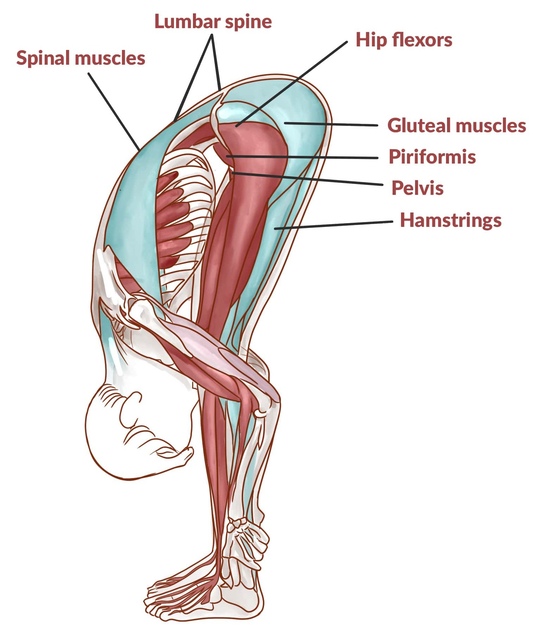
Gluteal Muscles
Similarly, the gluteal experience a stretch during forward bending poses. It's not a muscle group that we feel a lot initially when folding forward (most of the stretch is felt in the hamstrings); however, the glutes play an important role in determining the depth of your bend.
Hip Flexors
Opposite the hamstrings, these muscles on the front of the pelvis and thighs help control the forward bending motion. When they are flexible and strong, they can help you get deeper into the pose with more stability.
Pelvis
The pelvis is a crucial bony structure in the body, bearing a significant amount of the body's weight. It consists of two hip bones, one on each side. Where the top of the femur (or thigh bone) connects with the pelvis, we have the hip joint: a ball and socket joint. Due to the need to support the body's weight and absorb shock, this joint has to be very stable, which is why it has numerous ligaments for added stabilization.
Where the two hip bones meet at the back with the sacrum, we have the sacroiliac joint. It's imperative to maintain the integrity and stability of the lumbar spine and sacroiliac joint during yoga forward folds. Without a safe foundation of an anterior pelvic tilt, there's a risk of straining the muscles and fascia of the lower spine and SI joint, potentially leading to pain or injury.
Piriformis
When folding forward, especially in seated yoga poses, the piriformis muscle and the other external rotators muscles help stabilize the hip joint and the pelvis's position.
If these muscles are tight, they can limit your ability to tilt the pelvis forward. Moreover, in forward bends or hip openers where the legs are externally rotated, the piriformis and other external rotators are actively stretched, improving flexibility and boosting hip mobility.
Surrounding Core Muscles
Muscles like the rectus abdominis (front abdominal muscle) and the obliques (side abdominal muscles) provide stability and support during the bend, protecting the spine and aiding in the forward movement.
Lumbar Spine
This lower portion of the spine bends forward during the pose. A safe forward fold aims for an even curve in the lumbar region, avoiding excessive rounding, and ensuring the movement comes from the hips rather than the back.
Also Read - What is Yoga Anatomy
Thoracolumbar Fascia & Erector Spinae Muscles
Fascia plays a fundamental role in yoga asanas. In a yoga forward bend, the thoracolumbar fascia (a sheet of tissue in the lower back) and the erector spinae muscles (muscles along the spine) work together to provide stability and support to the spinal column. As you bend forward, the fascia offers support while the muscles stretch, helping to keep the spine straight and safe.
It’s also vital to note that each person’s body is different. As with any yoga posture, always listen to your body and consider individual anatomical differences.
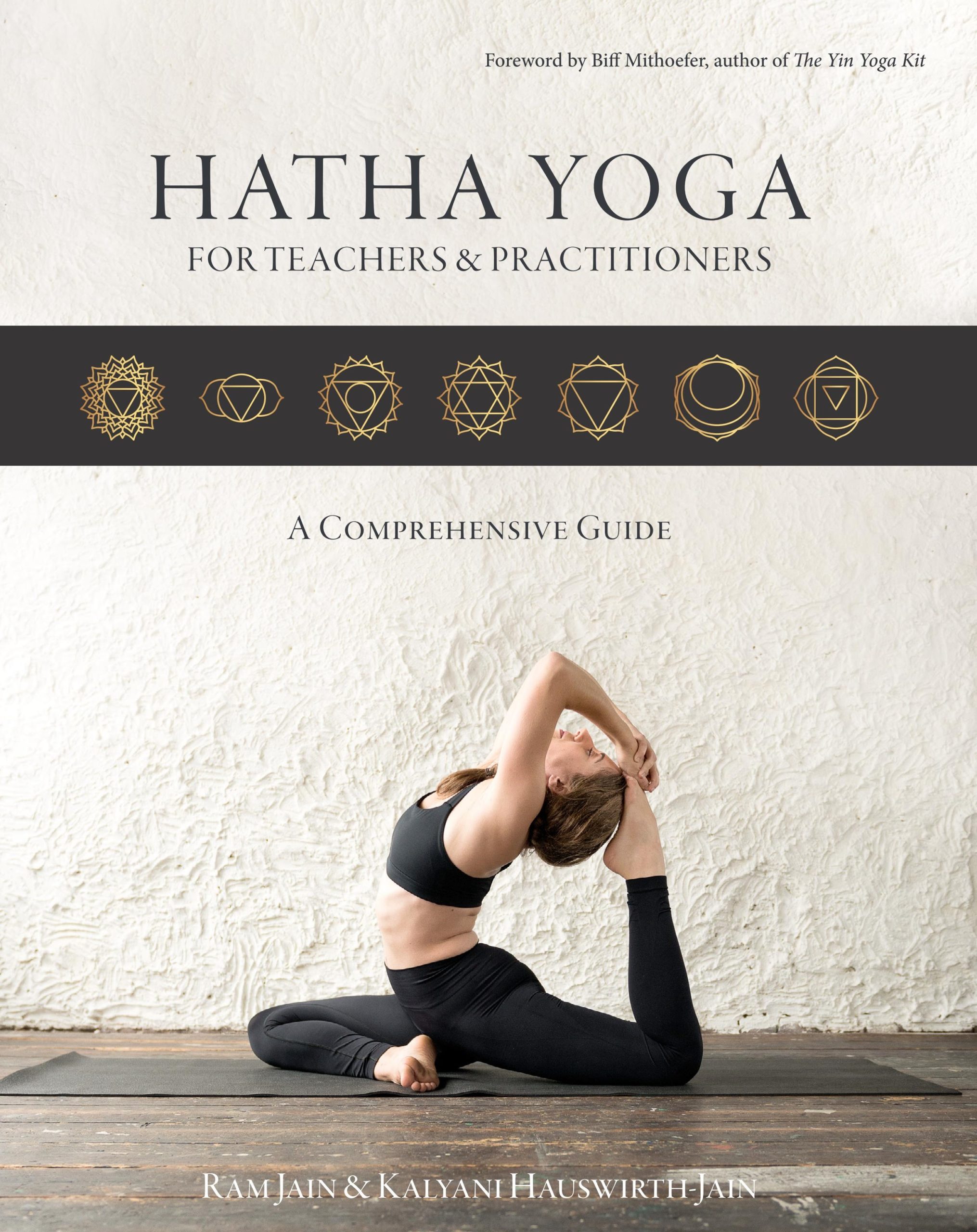
Get a free copy of our Amazon bestselling book directly into your inbox!
Learn how to practice, modify and sequence 250+ yoga postures according to ancient Hatha Yoga principles.
Benefits of Yoga Forward Bends
Yoga forward bends, when practiced safely, offer a myriad of physical and internal benefits. Here's a deeper dive into the advantages they bring:
1. Stretches the Back Body
The term ‘back body’ is frequently used in yoga, and it's not limited to just the back. It encompasses a broader area, including spines, back muscles, glutes, hamstrings, and calf muscles. Yoga forward bends is an effective method for lengthening and releasing tension throughout this entire area. This can bring relief for back and nerve pain conditions like sciatica.
2. Enhances Flexibility
Folds like the wide-legged yoga forward bend provide a targeted stretch on the adductor muscles, or the inner thighs. This not only improves leg flexibility but also aids in preventing inner thigh tightness, which can affect posture and overall movement.
See - Understanding Strength & Flexibility In Yoga
3. Improves Digestion
The combination of forward bends and deep, intentional breathing can improve digestion. This is because the folding motion gently compresses the abdominal region and stimulates the digestive tract, aiding in the movement of food and promoting better digestion.
4. Stimulates Vital Organs
During forward bends, there's a kind of ‘internal massage’ that occurs. This gentle pressure on the abdominal cavity stimulates organs like the liver and kidneys, potentially boosting their function and ensuring better detoxification processes.
5. Calms the Mind and Nervous System
Forward bends bring about a mild increase in blood pressure toward the head. This can have a profoundly calming effect on the nervous system and brain. As a result, practicing these bends can relieve stress and anxiety, promoting relaxation and mental clarity.
How to Do Yoga Forward Bends Safely: Beginner to Intermediate
For beginners, it’s safer to start off with simple forward bends to familiarize yourself with healthy pelvic and lumbar spine movement before advancing to more complex folds.
Beginner Level:
- Knee-to-chest Pose - Pawanmuktasana
- Child’s Pose - Shashankasana
In these poses, the knees are bent and move toward the chest. This allows for a safe and gentle stretching of the lower back.
Intermediate Level:
- Wide-Legged Forward Bend - Prasarita Padottanasana
- Seated Forward Bend - Paschimottanasana
Easy Forward Fold
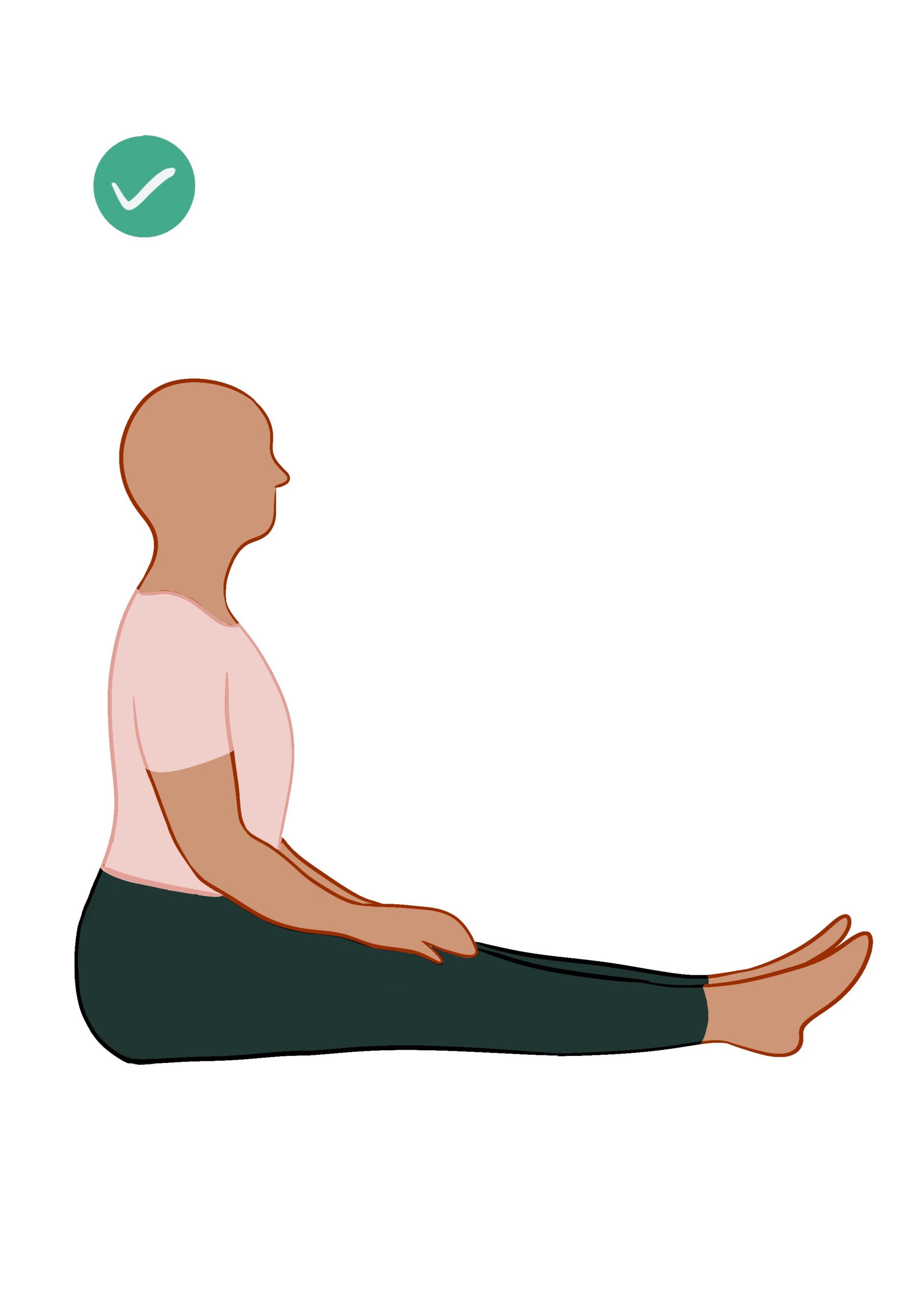
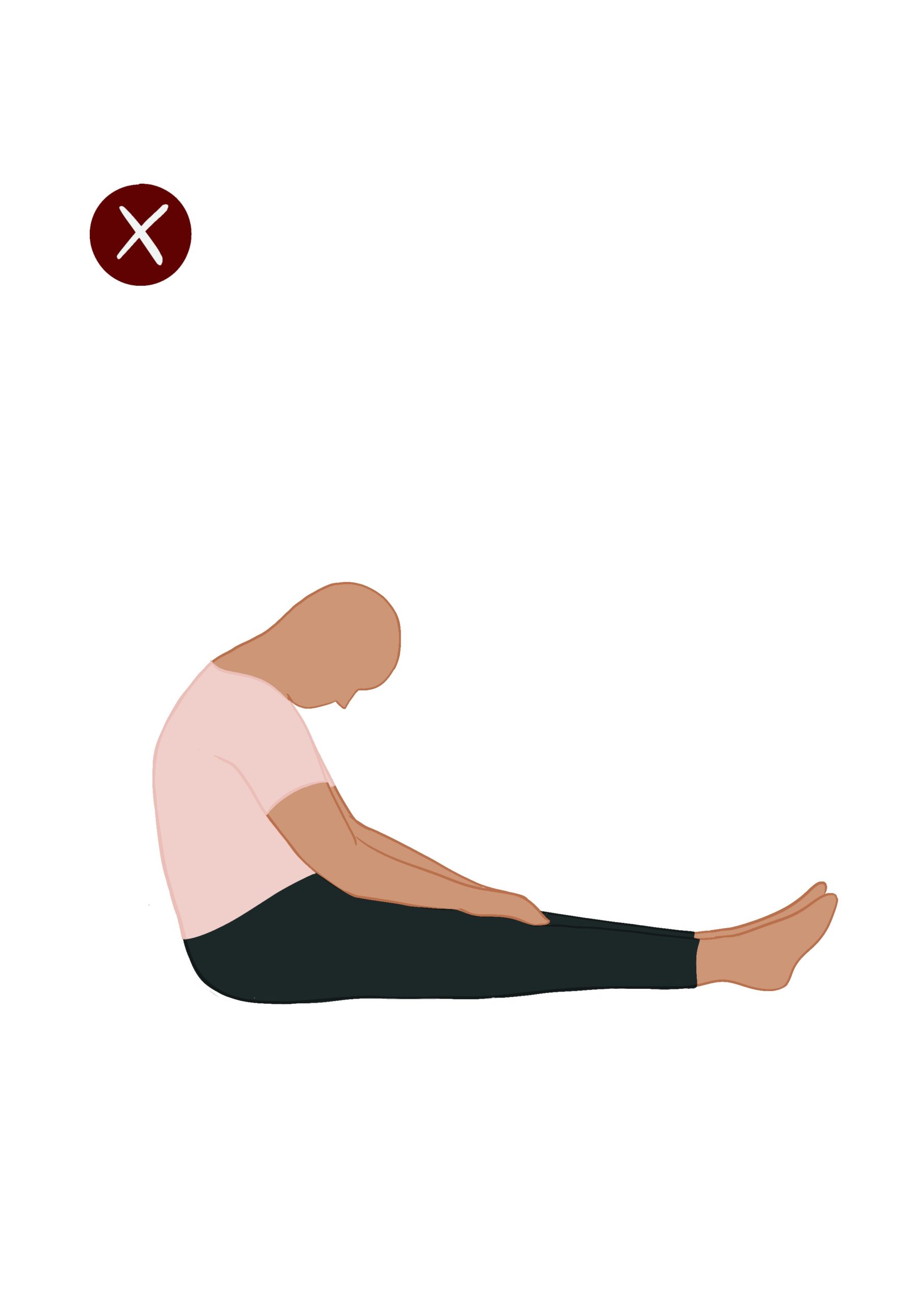
- Make sure you’re evenly balanced on your sitting bones
- As you fold forward, let the pelvis rotate around the femur — creating and maintaining an anterior pelvic tilt
- Keep your entire back elongated as you fold
- Only once you’ve reached your maximum, allow the back to round (from your thoracic spine upward)
Tips:
- If you have limited hip flexion, you can sit on the edge of a cushion or folded blankets to raise the hips above the knees. This elevation can help create an anterior pelvic tilt
- Typically, in yoga books, the knees are straight in forward bends. For those with tight glutes and hamstrings, keeping a micro-bend in the knees will help protect the back and leg muscles
Seated Forward Fold
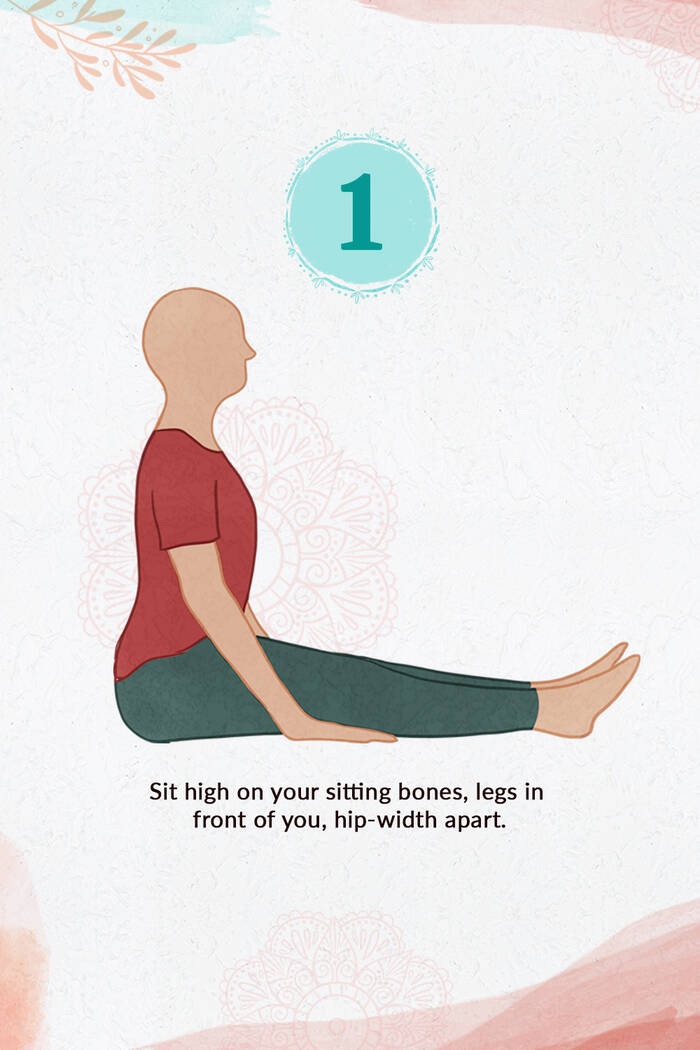
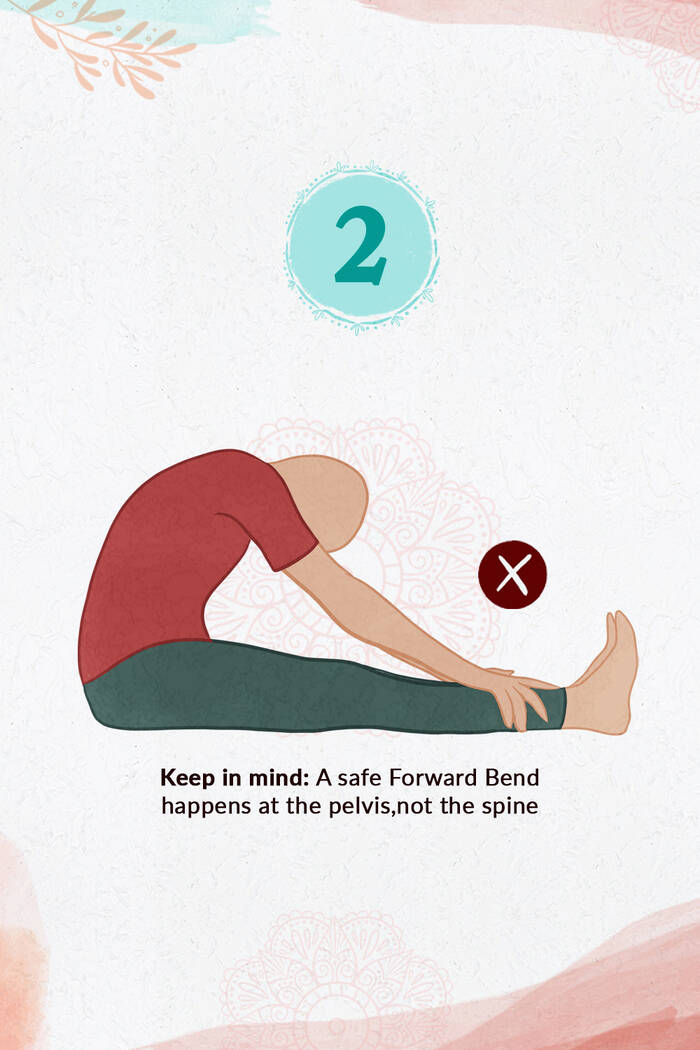
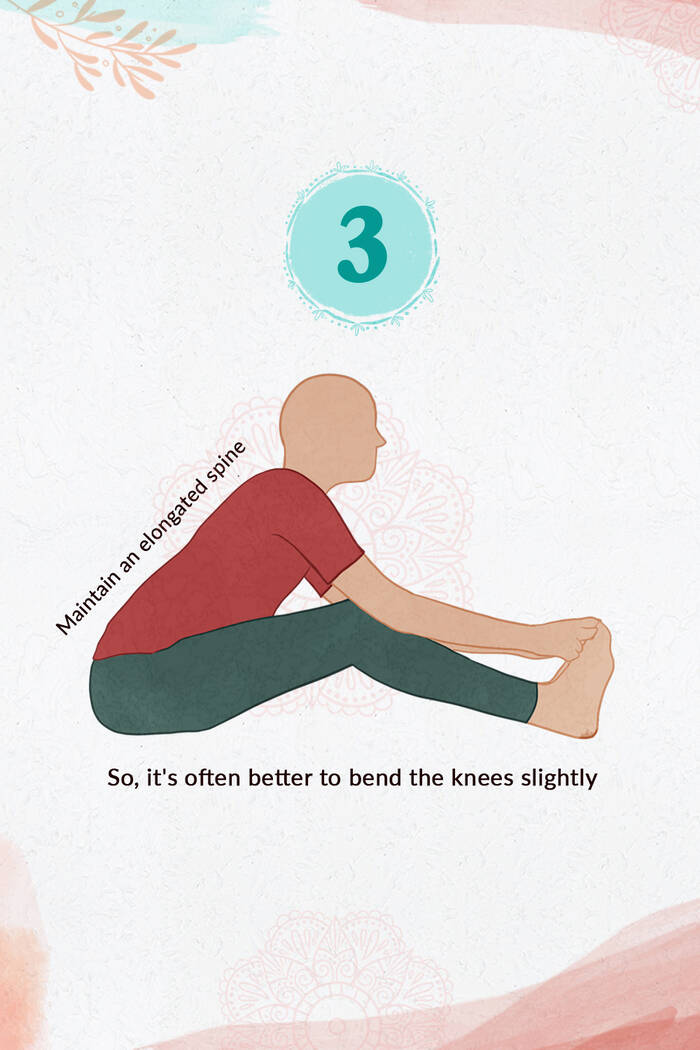
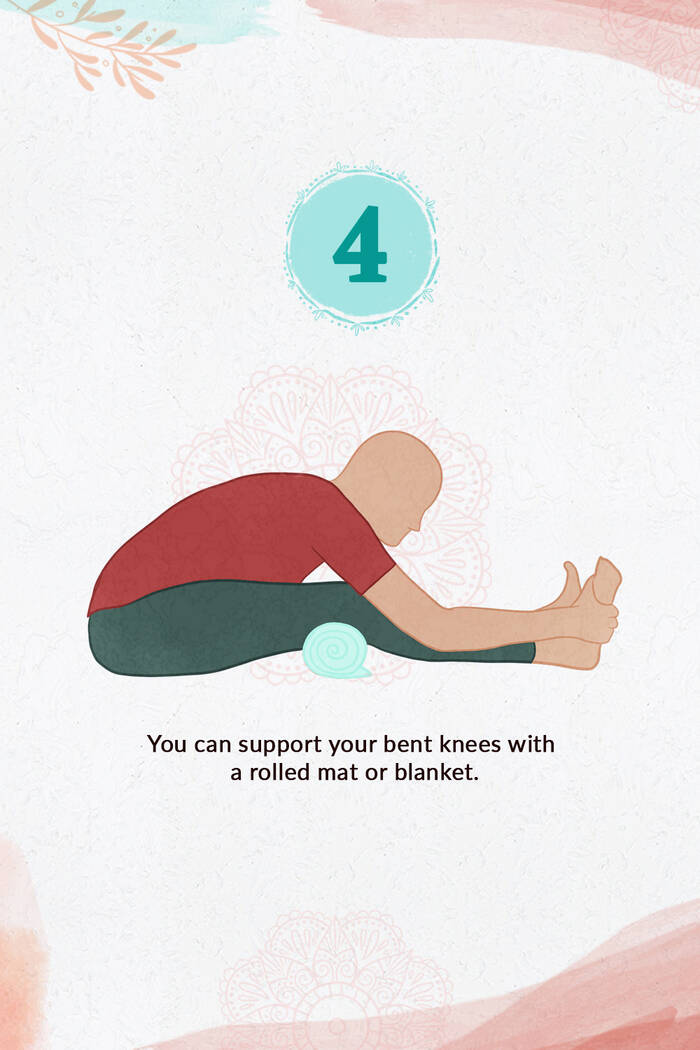
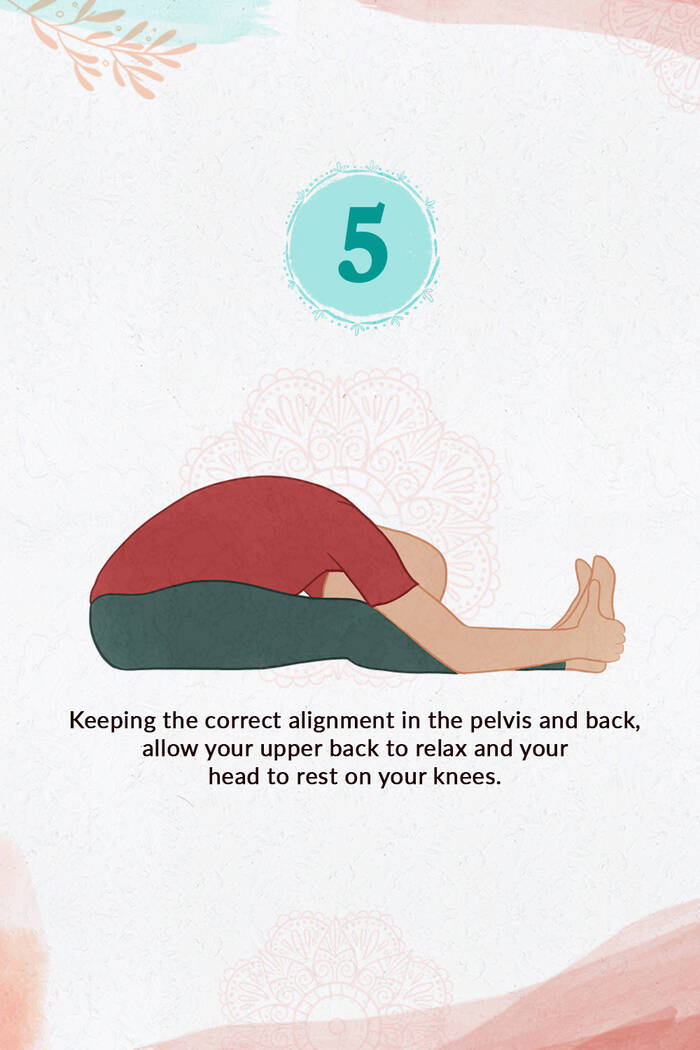
- Position yourself high up on your sitting bones with your legs hip-width apart and straight out in front of you
- Inhale and stretch your arms up towards the ceiling, in line with your ears
- Exhale and slowly fold your upper body forward. Reach for your heels but do not round your back. If you are unable to touch your heels, hold your shins, ankles, or knees
- As you fold forward, maintain an elongated spine and bend the knees slightly if needed. Only when you reach your maximum, allow the back to round (from your thoracic spine upward)
- Relax and hold the pose for a few minutes, remembering to breathe
For more seasoned practitioners, these yoga forward bends will help you experience a wider stretch along your back-body, involving your hamstrings too.
To help gain more mobility for forward bends, you can try Padmasana – Lotus Pose: Tutorial to a Pain-Free & Safe Lotus Pose and Eka Pada Kapotasana: How to Practice Pigeon Pose for All Levels of Mobility to get you moving in the right way!
Wide-Legged Forward Fold
- Begin in Tadasana (Mountain Pose) with your body parallel to your mat
- Place your hands on your hips and step your feet apart until they are one leg-length apart
- Inhale and lengthen your spine, pressing the soles of your feet into the mat
- On exhale, hinge at the hips and gently fold your torso forward. If you feel your back beginning to round, stop your descent and rest your hands on a yoga block. Keep you spine elongated
- Rest your hands in the center of your mat, between your legs
- Elongate your spine and deepen the fold with each breath
- If you reach the ground easily, reach with your head toward the floor using your hands and feet to anchor your body into the ground
- Stay here for several breaths before slowly rising and bringing your feet back together in Tadasana
Final Thought
Undoubtedly, yoga forward bends have so many benefits for the mind and body. Therefore, it is critical to practice yoga forward bends regularly and safely! Only then are they truly effective. Your forward bends will be transformed once you understand that safe forward bending starts with the pelvis and is not just bending forward from the hips or waist. Remember, we must take care of the back and spine when practicing yoga forward bends. Keeping this principle in mind will help to avoid injury.

Get a free copy of our Amazon bestselling book directly into your inbox!
Learn how to practice, modify and sequence 250+ yoga postures according to ancient Hatha Yoga principles.

